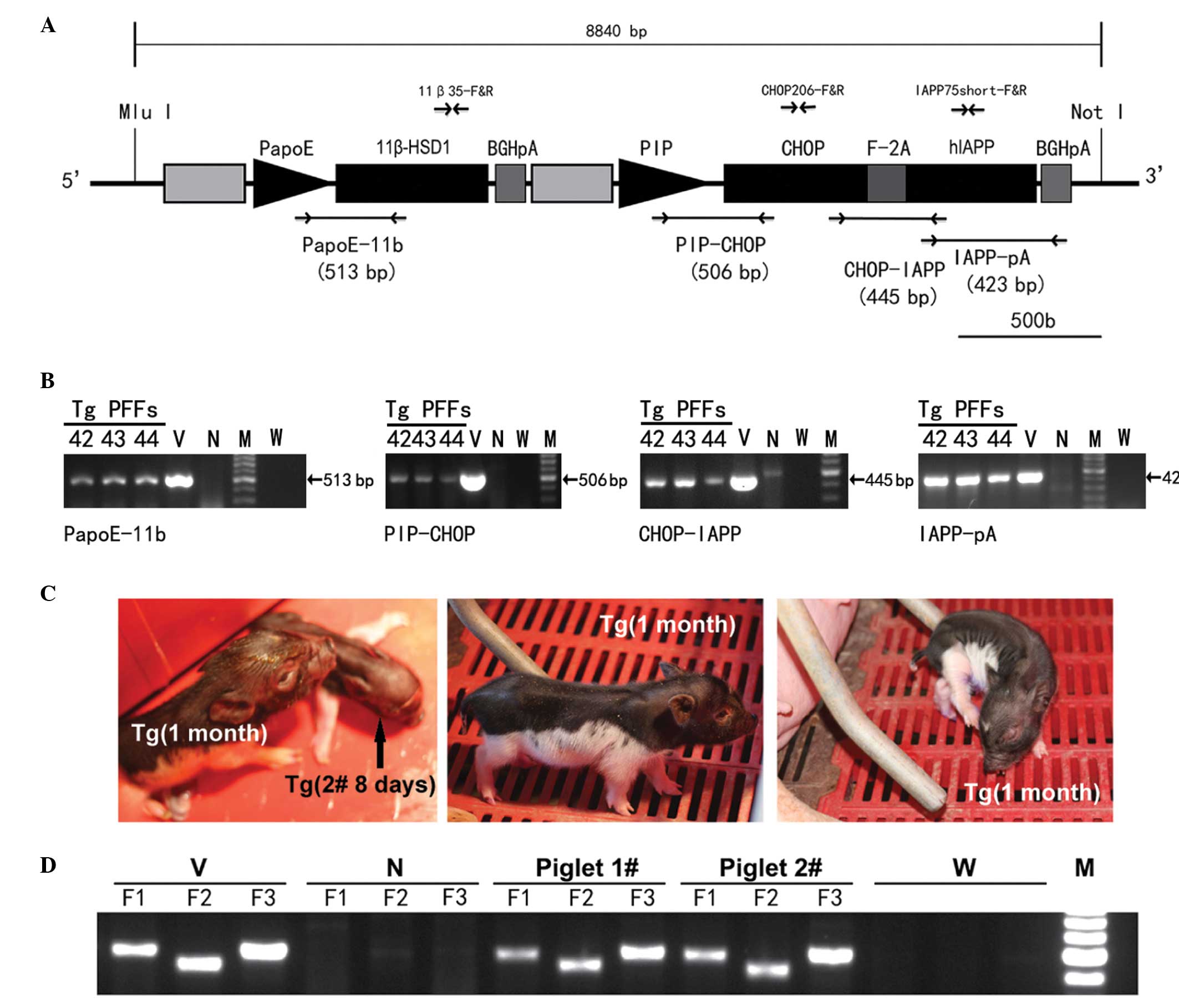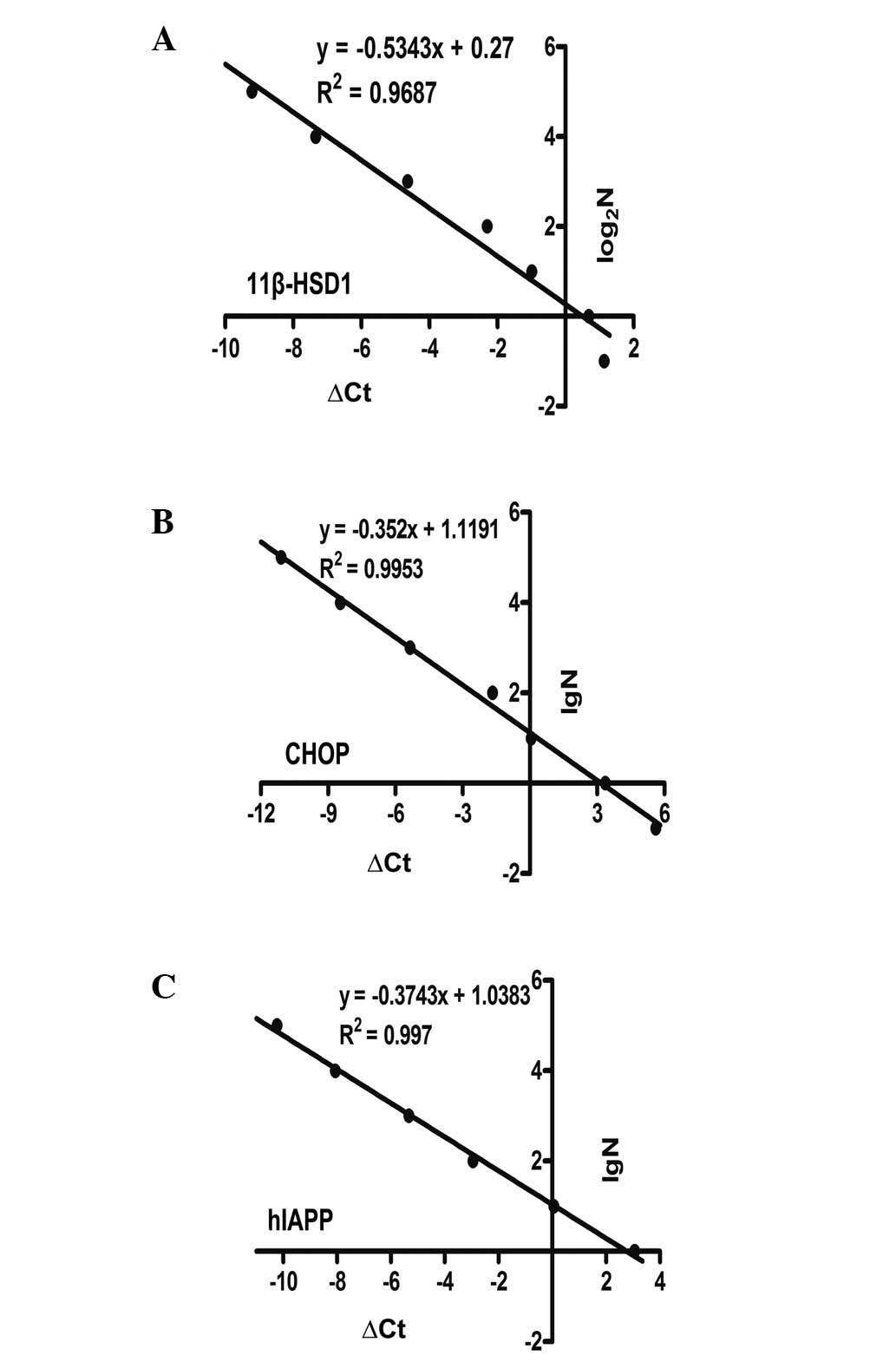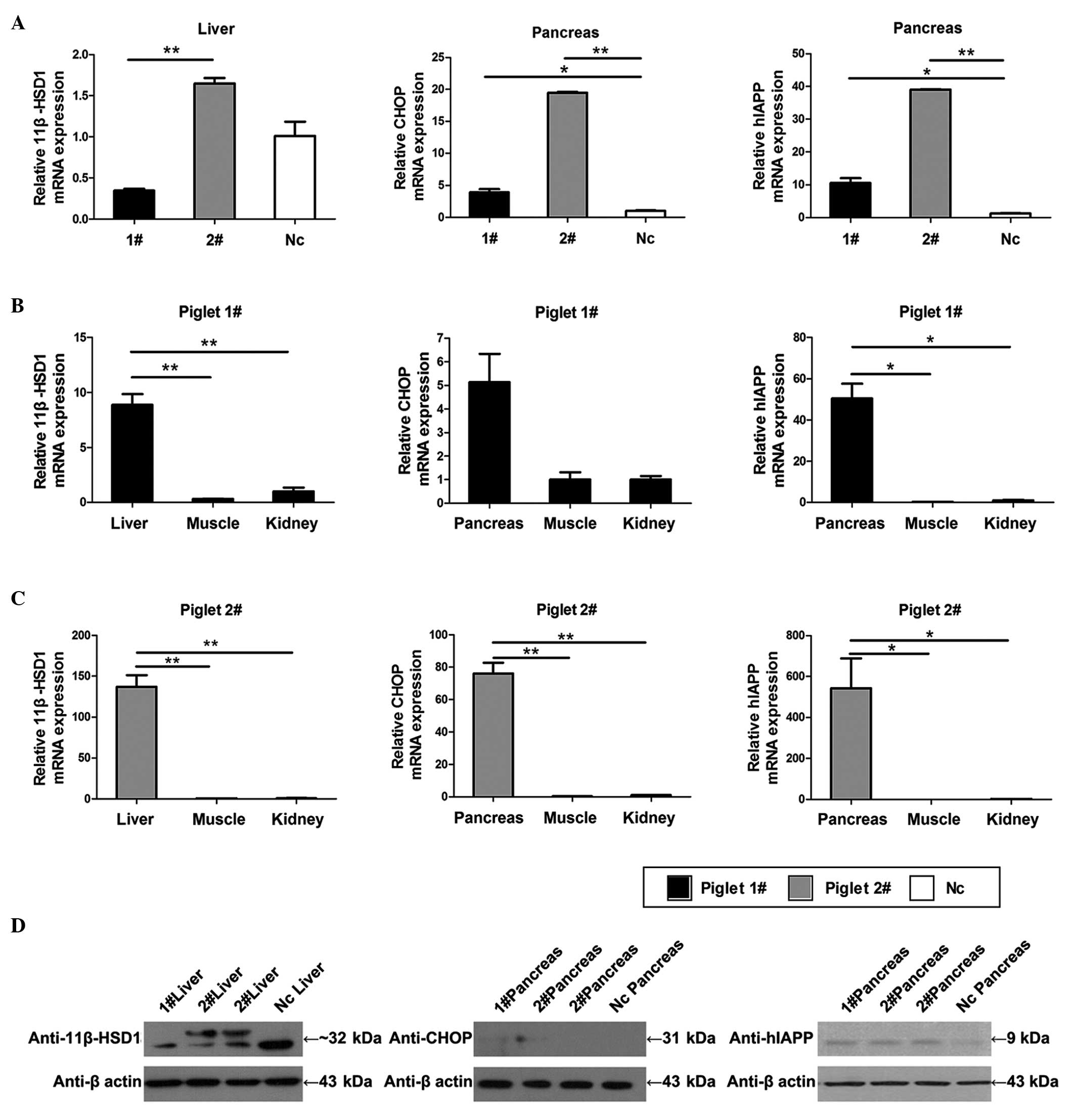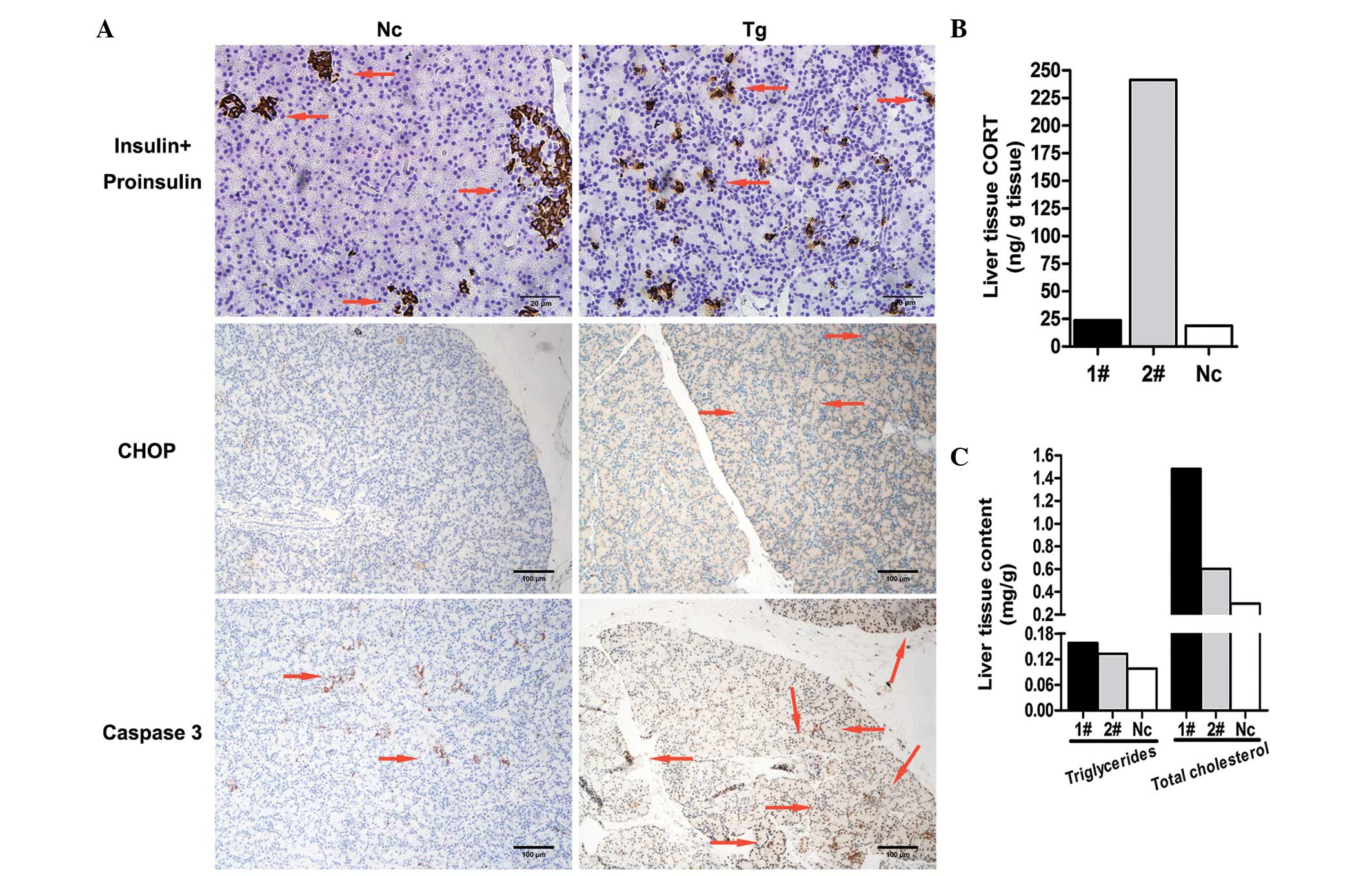|
1
|
American Diabetes Association: Diagnosis
and classification of diabetes mellitus. Diabetes care. 36(Suppl
1): S67–S74. 2013. View Article : Google Scholar : PubMed/NCBI
|
|
2
|
Masiello P: Animal models of type 2
diabetes with reduced pancreatic beta-cell mass. Int J Biochem Cell
Biol. 38:873–893. 2006. View Article : Google Scholar
|
|
3
|
Wolf E, Braun-Reichhart C, Streckel E and
Renner S: Genetically engineered pig models for diabetes research.
Transgenic Res. 23:27–38. 2014. View Article : Google Scholar
|
|
4
|
Rüster C and Wolf G: Models of diabetic
nephropathy. Drug discovery today: Disease models. 7:35–41.
2010.
|
|
5
|
Verma N, Rettenmeier AW and Schmitz-Spanke
S: Recent advances in the use of Sus scrofa (pig) as a model system
for proteomic studies. Proteomics. 11:776–793. 2011. View Article : Google Scholar : PubMed/NCBI
|
|
6
|
Liu H, Li Y, Wei Q, Liu C, Bolund L, Vajta
G, Dou H, Yang W, Xu Y, Luan J, et al: Development of transgenic
minipigs with expression of antimorphic human cryptochrome 1. PLoS
One. 8:e760982013. View Article : Google Scholar : PubMed/NCBI
|
|
7
|
Xia JH, Yuan J, Xin LL, Zhang Y, Kong S,
Chen Y, Yang S and Li K: Transcriptome analysis on the inflammatory
cell infiltration of nonalcoholic steatohepatitis in Bama minipigs
induced by a long-term high-fat, high-sucrose diet. Plos One.
9:e1137242014. View Article : Google Scholar : PubMed/NCBI
|
|
8
|
Xia JH, Zhang YY, Xin LL, Kong S, Chen Y,
Yang S and Li K: Global Transcriptomic Profiling of Cardiac
Hypertrophy and Fatty Heart Induced by Long-Term High-Energy Diet
in Bama Miniature Pigs. Plos One. 10:e01324202015. View Article : Google Scholar : PubMed/NCBI
|
|
9
|
Yang SL, Xia JH, Zhang YY, Fan JG, Wang H,
Yuan J, Zhao ZZ, Pan Q, Mu YL, Xin LL, Chen YX and Li K:
Hyperinsulinemia shifted energy supply from glucose to ketone
bodies in early nonalcoholic steatohepatitis from high-fat
high-sucrose diet induced Bama minipigs. Sci Rep. 5:139802015.
View Article : Google Scholar : PubMed/NCBI
|
|
10
|
Winzell MS and Ahrén B: The high-fat
diet-fed mouse - A model for studying mechanisms and treatment of
impaired glucose tolerance and type 2 diabetes. Diabetes.
53:S215–S219. 2004. View Article : Google Scholar
|
|
11
|
Danda RS, Habiba NM, Rincon-Choles H,
Bhandari BK, Barnes JL, Abboud HE and Pergola PE: Kidney
involvement in a nongenetic rat model of type 2 diabetes. Kidney
Int. 68:2562–2571. 2005. View Article : Google Scholar : PubMed/NCBI
|
|
12
|
Deng W, Yang D, Zhao B, Ouyang Z, Song J,
Fan N, Liu Z, Zhao Y, Wu Q, Nashun B, et al: Use of the 2A peptide
for generation of multi-transgenic pigs through a single round of
nuclear transfer. PLoS One. 6:e199862011. View Article : Google Scholar : PubMed/NCBI
|
|
13
|
Dieckhoff B, Kessler B, Jobst D, Kues W,
Petersen B, Pfeifer A, Kurth R, Niemann H, Wolf E and Denner J:
Distribution and expression of porcine endogenous retroviruses in
multi-transgenic pigs generated for xenotransplantation.
Xenotransplantation. 16:64–73. 2009. View Article : Google Scholar : PubMed/NCBI
|
|
14
|
Webster NL, Forni M, Bacci ML, Giovannoni
R, Razzini R, Fantinati P, Zannoni A, Fusetti L, Dalprà L, Bianco
MR, et al: Multi-transgenic pigs expressing three fluorescent
proteins produced with high efficiency by sperm mediated gene
transfer. Mol Reprod Dev. 72:68–76. 2005. View Article : Google Scholar : PubMed/NCBI
|
|
15
|
Jeong YH, Park CH, Jang GH, Jeong YI,
Hwang IS, Jeong YW, Kim YK, Shin T, Kim NH, Hyun SH, et al:
Production of multiple transgenic Yucatan miniature pigs expressing
human complement regulatory factors, human CD55, CD59 and
H-transferase genes. PLoS One. 8:e632412013. View Article : Google Scholar
|
|
16
|
Park SJ, Cho B, Koo OJ, Kim H, Kang JT,
Hurh S, Kim SJ, Yeom HJ, Moon J, Lee EM, et al: Production and
characterization of soluble human TNFRI-Fc and human HO-1 (HMOX1)
transgenic pigs by using the F2A peptide. Transgenic Res.
23:407–419. 2014. View Article : Google Scholar : PubMed/NCBI
|
|
17
|
Renner S, Braun-Reichhart C, Blutke A,
Herbach N, Emrich D, Streckel E, Wünsch A, Kessler B, Kurome M,
Bähr A, et al: Permanent neonatal diabetes in INS (C94Y) transgenic
pigs. Diabetes. 62:1505–1511. 2013. View Article : Google Scholar : PubMed/NCBI
|
|
18
|
Umeyama K, Watanabe M, Saito H, Kurome M,
Tohi S, Matsunari H, Miki K and Nagashima H: Dominant-negative
mutant hepatocyte nuclear factor 1alpha induces diabetes in
transgenic-cloned pigs. Transgenic Res. 18:697–706. 2009.
View Article : Google Scholar : PubMed/NCBI
|
|
19
|
Renner S, Fehlings C, Herbach N, Hofmann
A, von Waldthausen DC, Kessler B, Ulrichs K, Chodnevskaja I,
Moskalenko V, Amselgruber W, et al: Glucose intolerance and reduced
proliferation of pancreatic beta-cells in transgenic pigs with
impaired glucose-dependent insulinotropic polypeptide function.
Diabetes. 59:1228–1238. 2010. View Article : Google Scholar : PubMed/NCBI
|
|
20
|
Masuzaki H, Paterson J, Shinyama H, Morton
NM, Mullins JJ, Seckl JR and Flier JS: A transgenic model of
visceral obesity and the metabolic syndrome. Science.
294:2166–2170. 2001. View Article : Google Scholar : PubMed/NCBI
|
|
21
|
Mathis D, Vence L and Benoist C: beta-cell
death during progression to diabetes. Nature. 414:792–798. 2001.
View Article : Google Scholar : PubMed/NCBI
|
|
22
|
Maris M, Overbergh L, Gysemans C, Waget A,
Cardozo AK, Verdrengh E, Cunha JP, Gotoh T, Cnop M, et al: Deletion
of C/EBP homologous protein (Chop) in C57Bl/6 mice dissociates
obesity from insulin resistance. Diabetologia. 55:1167–1178. 2012.
View Article : Google Scholar : PubMed/NCBI
|
|
23
|
Hoppener JWM, Jacobs HM, Wierup N,
Sotthewes G, Sprong M, de Vos P, Berger R, Sundler F and Ahrén B:
Human islet amyloid polypeptide transgenic mice: In vivo and ex
vivo models for the role of hIAPP in type 2 diabetes mellitus. Exp
Diabetes Res. 2008:6970352008. View Article : Google Scholar : PubMed/NCBI
|
|
24
|
Paterson JM, Morton NM, Fievet C, Kenyon
CJ, Holmes MC, Staels B, Seckl JR and Mullins JJ: Metabolic
syndrome without obesity: Hepatic overexpression of
11beta-hydroxysteroid dehydrogenase type 1 in transgenic mice. Proc
Natl Acad Sci USA. 101:7088–7093. 2004. View Article : Google Scholar : PubMed/NCBI
|
|
25
|
Hull RL, Shen ZP, Watts MR, Kodama K, Carr
DB, Utzschneider KM, Zraika S, Wang F and Kahn SE: Long-term
treatment with rosiglitazone and metformin reduces the extent of,
but does not prevent, islet antyloid deposition in mice expressing
the gene for human islet antyloid polypeptide. Diabetes.
54:2235–2244. 2005. View Article : Google Scholar : PubMed/NCBI
|
|
26
|
Masuzaki H and Flier JS: Tissue-specific
glucocorticoid reactivating enzyme, 11 beta-hydroxysteroid
dehydrogenase type 1 (11 beta-HSD1) - a promising drug target for
the treatment of metabolic syndrome. Curr Drug Targets Immune
Endocr Metabol Disord. 3:255–262. 2003. View Article : Google Scholar : PubMed/NCBI
|
|
27
|
Chen ZY, Liu SN, Li CN, et al:
Atorvastatin helps preserve pancreatic beta cell function in obese
C57BL/6 J mice and the effect is related to increased pancreas
proliferation and amelioration of endoplasmic-reticulum stress.
Lipids Health Dis. 13:2014. View Article : Google Scholar
|
|
28
|
West AG, Gaszner M and Felsenfeld G:
Insulators: Many functions, many mechanisms. Genes Dev. 16:271–288.
2002. View Article : Google Scholar : PubMed/NCBI
|
|
29
|
Xia J, Hu B, Mu Y, Xin L, Yang S and Li K:
Molecular cloning and characterization of the promoter region of
the porcine apolipoprotein E gene. Mol Biol Rep. 41:3211–3217.
2014. View Article : Google Scholar : PubMed/NCBI
|
|
30
|
Ruan JX, Li HG, Xu K, Wu T, Wei J, Zhou R,
Liu Z, Mu Y, Yang S, Ouyang H, et al: Highly efficient
CRISPR/Cas9-mediated transgene knockin at the H11 locus in pigs.
Sci Rep. 5:142532015. View Article : Google Scholar : PubMed/NCBI
|
|
31
|
Lai L, Kolber-Simonds D, Park KW, Cheong
HT, Greenstein JL, Im GS, Samuel M, Bonk A, Rieke A, Day BN, et al:
Production of alpha-1,3-galactosyltransferase knockout pigs by
nuclear transfer cloning. Science. 295:1089–1092. 2002. View Article : Google Scholar : PubMed/NCBI
|
|
32
|
Livak KJ and Schmittgen TD: Analysis of
relative gene expression data using real-time quantitative PCR and
the 2(T)(-Delta Delta C) method. Methods. 25:402–408. 2001.
View Article : Google Scholar
|
|
33
|
Bubner B and Baldwin IT: Use of real-time
PCR for determining copy number and zygosity in transgenic plants.
Plant Cell Rep. 23:263–271. 2004. View Article : Google Scholar : PubMed/NCBI
|
|
34
|
Luo W, Li Z, Huang Y, Han Y, Yao C, Duan
X, Ouyang H and Li L: Generation of AQP2-Cre transgenic mini-pigs
specifically expressing Cre recombinase in kidney collecting duct
cells. Transgenic Res. 23:365–375. 2014. View Article : Google Scholar
|
|
35
|
Li L, Li Q, Bao Y, Li J, Chen Z, Yu X,
Zhao Y, Tian K and Li N: RNAi-based inhibition of porcine
reproductive and respiratory syndrome virus replication in
transgenic pigs. J Biotechnol. 171:17–24. 2014. View Article : Google Scholar
|
|
36
|
Zhang Y, Wong CH, Birnbaum RY, Li G,
Favaro R, Ngan CY, Lim J, Tai E, Poh HM, Wong E, et al: Chromatin
connectivity maps reveal dynamic promoter-enhancer long-range
associations. Nature. 504:306–310. 2013. View Article : Google Scholar : PubMed/NCBI
|
|
37
|
Sadeghnia HR, Ghorbani Hesari T,
Mortazavian SM, Mousavi SH, Tayarani-Najaran Z and Ghorbani A:
Viola tricolor induces apoptosis in cancer cells and exhibits
antiangiogenic activity on chicken chorioallantoic membrane. Biomed
Res Int. 2014:6257922014. View Article : Google Scholar : PubMed/NCBI
|
|
38
|
Rabhi N, Salas E, Froguel P and Annicotte
JS: Role of the unfolded protein response in β cell compensation
and failure during diabetes. J Diabetes Res. 2014:7951712014.
View Article : Google Scholar
|
|
39
|
Morton NM, Paterson JM, Masuzaki H, Holmes
MC, Staels B, Fievet C, Walker BR, Flier JS, Mullins JJ and Seckl
JR: Novel adipose tissue-mediated resistance to diet-induced
visceral obesity in 11 beta-hydroxysteroid dehydrogenase type
1-deficient mice. Diabetes. 53:931–938. 2004. View Article : Google Scholar : PubMed/NCBI
|
|
40
|
Paterson JM, Holmes MC, Kenyon CJ, Carter
R, Mullins JJ and Seckl JR: Liver-selective transgene rescue of
hypothalamic-pituitary-adrenal axis dysfunction in 11
beta-hydroxysteroid dehydrogenase type 1-deficient mice.
Endocrinology. 148:961–966. 2007. View Article : Google Scholar
|
|
41
|
Lee AW and Cox RD: Use of mouse models in
studying type 2 diabetes mellitus. Expert Rev Mol Med. 13:e12011.
View Article : Google Scholar : PubMed/NCBI
|
|
42
|
Jung EM, An BS, Kim YK, Jeong YH, Hwang WS
and Jeung EB: Generation of porcine fibroblasts overexpressing
11β-HSD1 with adipose tissue-specific aP2 promoter as a porcine
model of metabolic syndrome. Mol Med Rep. 8:751–756.
2013.PubMed/NCBI
|
|
43
|
Jeon Y, Kim Y, Yoon J, Cai L, Hwang SU,
Kim E, Lee S, Jeung EB and Hyun SH: Production of
11β-hydroxysteroid dehydrogenase type 1 (11β-HSD1) over-expressed
pigs for the study of metabolic syndrome disease. Reprod Fertil
Dev. 26:116. 2014. View Article : Google Scholar
|
|
44
|
Bram Y, Frydman-Marom A, Yanai I, Gilead
S, Shaltiel-Karyo R, Amdursky N and Gazit E: Apoptosis induced by
islet amyloid polypeptide soluble oligomers is neutralized by
diabetes-associated specific antibodies. Sci Rep. 4:42672014.
View Article : Google Scholar : PubMed/NCBI
|
|
45
|
Hull RL, Andrikopoulos S, Verchere CB,
Vidal J, Wang F, Cnop M, Prigeon RL and Kahn SE: Increased dietary
fat promotes islet amyloid formation and beta-cell secretory
dysfunction in a transgenic mouse model of islet amyloid. Diabetes.
52:372–379. 2003. View Article : Google Scholar : PubMed/NCBI
|
|
46
|
Oyadomari S and Mori M: Roles of
CHOP/GADD153 in endoplasmic reticulum stress. Cell Death Differ.
11:381–389. 2004. View Article : Google Scholar
|
|
47
|
Marchetti P, Bugliani M, Lupi R, Marselli
L, Masini M, Boggi U, Filipponi F, Weir GC, Eizirik DL and Cnop M:
The endoplasmic reticulum in pancreatic beta cells of type 2
diabetes patients. Diabetologia. 50:2486–2494. 2007. View Article : Google Scholar : PubMed/NCBI
|













